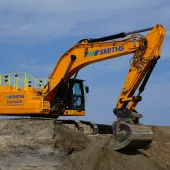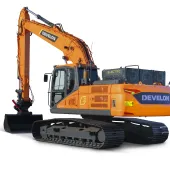Direct Extraction

In situations where urban encroachment places limits on drilling and blasting, ripping and loading using excavators can be a viable alternative, as Rob Sinclair explains
As working faces move closer to local communities, the direct extraction of weaker rocks is often the only option if quarrying is to continue. Direct extraction can also be referred to as free digging — the extraction of virgin or unblasted material.
If the rock has to be hauled any distance, the possibility of using solely a dozer (crawler tractor) with ripper is eliminated. Therefore, unless a dozer rips and an excavator loads, essentially the following possibilities remain:
- An excavator extracts and loads the rock using a bucket only.
- One excavator continuously rips and a second unit loads. Obviously, by employing a second excavator, costs will be increased, but production should remain high and can match, approximately, that obtained when using drilling and blasting.
- Rip and load, whereby one excavator alternates between using a ripper tooth and a bucket by means of a quick-coupler. This can be an excellent method, but to obtain similar production levels to those achievable if drilling, blasting and loading, a larger excavator will be required at increased purchase/running cost.
- Use of a hydraulic breaker, although this will require a second excavator to load the material.
Bucket only
To remove rock using the bucket only, one or more of the following must be evident: the rock must have a relatively low uniaxial compressive strength; must have been subjected to extensive weathering and/or contain sufficient natural faults, fractures, laminations; and must have relatively low bonding strength. If so, the use of an excavator of suitable proportions and bucket capacity may be possible, depending on production requirements.
If a considerably larger unit is required, then its associated costs (ie purchasing and running) will often prove more expensive than drilling and blasting, although this might be the only acceptable method.
Sedimentary rocks such as limestone and sandstone can often be extracted without the use of (or with lesser use of) explosives, although it is important to emphasize that sites and material within the same rock classification can vary considerably. For example, Carboniferous limestone is often more difficult to extract than Jurassic limestone, having been compressed for many millions of years longer, although both are frequently extracted without the use of explosives.
However, a possible problem when using the bucket only is the potential to remove unsuitably large fragments. While these can be reduced by means of a drop ball, for example, frequent use of this tool can prove time-consuming and, therefore, reduce efficiency.
The Liebherr RH120-E shown in figures 1 and 2 extracts two specific types of material in close proximity in one area of a site; the stronger and considerably more demanding material is known locally as jura (Jurassic), zeta, hangende bauk kalke, and the second as mergel.
The stronger, homogenous zeta exhibits few laminations, fractures or natural faults and has a uniaxial compressive strength of approximately 220MPa. Initially, the site’s Caterpillar D11R ripped the material down to 7m (23ft). However, beyond this the rock is further compressed and a maximum of only 200 tonnes/h was achievable – some 600 tonnes less than required.
As a result, two possible methods remained. Although the use of explosives is permitted, due to the location of a residential area and the risks of subsidence, the velocity of detonation would not be permitted to exceed 1,000m/s (3,280ft/s), and would, therefore, be largely ineffective. In addition, the site wanted to ensure its continued good-neighbour policy, so a decision was made to utilize a hydraulic excavator for direct extraction.
The solution was to acquire an excavator that could achieve either 800 tonnes of zeta or 1,500 tonnes of mergel per hour. Unusually for a large mining-class model, the machine was installed and had to prove its ability to attain the required production before being purchased. During its evaluation, the RH120-E averaged 848 tonnes of zeta per hour using 121 litres of fuel; thus, the machine remained on-site, a decision that subsequently proved very successful.
Ripping process
Ripping was, for many years, the preserve of large dozers (horizontal ripping), usually with single-shank rippers. However, over the past decade hydraulic excavators performing vertical ripping with a ripper tooth have increasingly been seen as a viable alternative, usually undertaken by 60- to 120-tonne class machines.
With ripping, the fragmentation is influenced by the ripper tooth width and, therefore, the operator has greater influence over the size of the material than if it had been blasted. Thus, a more uniform size that can be processed by the crusher is produced, while fines, lower value or waste materials are also reduced.
Two methods can be employed; first, continuous ripping whereby one excavator is dedicated to ripping the material and followed along the bench by a second, usually smaller unit, which loads the material into dumptrucks or an in-pit crushing system. Occasionally, an excavator rips and then, using the bucket, casts the material aside to be rehandled using a wheel loader, which loads into the in-pit crusher.
The second method is referred to as ‘rip and load’. As the name suggests, the excavator rips the material, usually for aggregate or dimension stone purposes, subsequently loading it into trucks by use of the bucket.
Dedicated ripping
Excavators of 30 to 45 tonnes are sometimes used to rip in small quarries but this is a rarity. More often, excavators weighing at least 70 tonnes are used because of their extra mass and power to produce reasonably high volumes, together with sufficient durability to withstand this type of demanding application.
If continuously ripping, a 70-tonne-class excavator is quite capable of matching a 70-tonne-class dozer in terms of material ripped, while the amount of fuel consumed by the most frugal examples in this class is noticeably less. Furthermore, their initial purchase price is also less.
In a ripping application, the excavator is, not surprisingly, subjected to considerable stresses, but so too is the dozer and its undercarriage wear will be greater than that of the excavator.
The dozer, though, will prove advantageous if the ripped material is to be moved to a stockpile up to about 100m (300ft) away. This is because, once ripped, it can push the material to the desired location. In contrast, if ripped by an excavator, the rock must be loaded into trucks by a second unit, significantly increasing the cost per tonne.
Rip and load
During this process, the excavator alternates between the ripper and bucket by use of a quick-coupler.
Depending on the size of the excavator, the material being ripped, and site conditions/efficiencies, a 45-tonne-class machine can rip and load into haulers at about 150 to 250 tonnes/h. The 70- to 85-tonne class can rip and load about 200 to 400 tonnes and the 110- to 120-tonne class about 400 to 600 tonnes. Although an excavator performing rip and load will, of course, never achieve the same hourly production as it would loading blasted material, an ability to penetrate the material using the ripper tooth means it has the potential to replace a larger excavator that works the site using the bucket only. Thus, it may be possible to reduce purchase and operating costs.
Assuming the rock can be ripped, if it must be hauled by truck (ie primarily due to distance) the rip and load technique is the most effective ripping method. However, the question remains as to whether the excavator can achieve the required tonnage previously achieved using a smaller excavator to load the pre-blasted material.
Increasingly, quarries are reaping the benefits of direct means of extraction. Although drilling and blasting costs are either eliminated or significantly reduced, there are risks, particularly when using one machine to rip and another to load; thus, it may prove impossible to offset their associated costs. In addition, because use of the bucket only or ripping normally requires an over-sized excavator, its subsequent costs are significantly higher.
As such, its premium may again prove uneconomical in comparison with drilling and blasting, unless a single machine undertakes both ripping and loading duties, ie ‘rip and load’.
If production requirements can be achieved, vertical ripping can be an excellent alternative to drilling and blasting, not only in terms of reducing or eliminating costs, but also in minimizing disruption to production and better meeting environmental needs. However, to ascertain if ripping may provide desirable benefits at a specific site, a site evaluation is required.
Rob Sinclair is the author of the book Hydraulic Excavators: Quarrying & Mining Applications (Sinclair Publishing, 2012, ISBN 9781906148355). He has worked in the quarrying industry for more than a decade, variously as an assistant plant manager, sales engineer and excavator product specialist.
This article first appeared in the October 2012 edition of Quarry, the official journal of the Institute of Quarrying Australia, and is reproduced here by kind permission.








